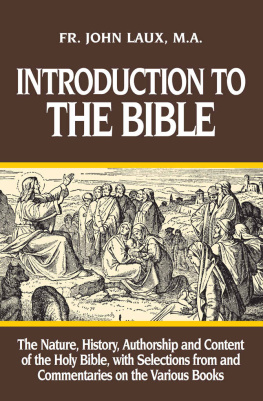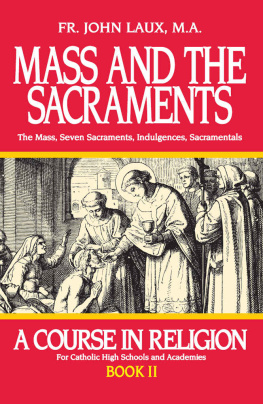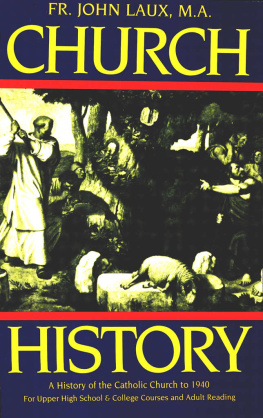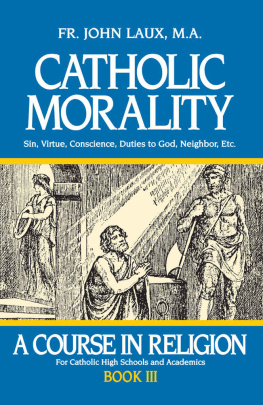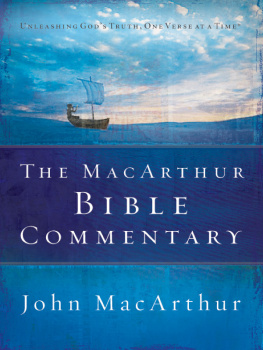Rev. Fr. John Laux - Introduction to the Bible
Here you can read online Rev. Fr. John Laux - Introduction to the Bible full text of the book (entire story) in english for free. Download pdf and epub, get meaning, cover and reviews about this ebook. year: 2015, publisher: TAN Books, genre: Religion. Description of the work, (preface) as well as reviews are available. Best literature library LitArk.com created for fans of good reading and offers a wide selection of genres:
Romance novel
Science fiction
Adventure
Detective
Science
History
Home and family
Prose
Art
Politics
Computer
Non-fiction
Religion
Business
Children
Humor
Choose a favorite category and find really read worthwhile books. Enjoy immersion in the world of imagination, feel the emotions of the characters or learn something new for yourself, make an fascinating discovery.
- Book:Introduction to the Bible
- Author:
- Publisher:TAN Books
- Genre:
- Year:2015
- Rating:3 / 5
- Favourites:Add to favourites
- Your mark:
- 60
- 1
- 2
- 3
- 4
- 5
Introduction to the Bible: summary, description and annotation
We offer to read an annotation, description, summary or preface (depends on what the author of the book "Introduction to the Bible" wrote himself). If you haven't found the necessary information about the book — write in the comments, we will try to find it.
Introduction to the Bible — read online for free the complete book (whole text) full work
Below is the text of the book, divided by pages. System saving the place of the last page read, allows you to conveniently read the book "Introduction to the Bible" online for free, without having to search again every time where you left off. Put a bookmark, and you can go to the page where you finished reading at any time.
Font size:
Interval:
Bookmark:
Introduction to the Bible
The Nature, History, Authorship and Content of the Holy Bible with Selections from and Commentaries on the Various Books
Fr. John Laux, M.A.
Nihil Obstat: Arthur J. Scanlan, S.T.D.
Censor Librorum
Imprimatur: + Patrick Cardinal Hayes
Archbishop of New York
August 20, 1932
Copyright 1932 by Benziger Brothers.
Originally published in 1932 by Benziger Brothers, New York, from which this present edition was photographically reproduced complete and unabridged with the addition of a few footnotes.
Copyright 1990 by TAN Books.
Library of Congress Catalog Card No.: 90-70241
Cover illustration: Christ teaches the people during the Sermons on the Mount.
TAN Books
Charlotte, North Carolina
www.TANBooks.com
2012

St. John the Evangelist on the Island of Patmos receiving the revelations for the Apocalypse .
PREFACE
It is a commonplace that the reading of the Scriptures on the part of Catholics is sadly neglected. It is true not only of those who have received but an elementary education, but also of those who have gone through a secondary school and even college. The reason is not hard to find. The Catholic looks to a living Church as the source of his Religionhis teacher in faith and morals. Yet St. Peter tells us, "But sanctify the Lord Christ in your hearts, being ready always to satisfy every one that asketh you a reason of the hope which is in you." To give an account of this hope which is in us would seem to imply not merely a knowledge of what the Church teaches but why the Church teaches it; together with some acquaintance with the main source from which the Church draws her teaching, namely, the Bible.
Another reason for the lack of adequate acquaintance of Catholics with the Bible is that this is no longer the focal point of attack on the Church. For a time after the Religious Revolution of the sixteenth century Catholic apologists and their chief antagonists had this much in commonboth recognized the Scriptures as the revealed word of God. Their quarrel was on the interpretation of the Scriptures. Today the battle has shifted to more fundamental grounds. The question at issue is the very nature of God. The tendency today is to oppose a Pantheistic to a Theistic God. On the outcome of this issue the case for revelation stands or falls. If God be but "the unifying principle in the universe"; or the Elan Vital of an evolutionary process; or the sum total of physical nature; or any one of a dozen modern views, then the very possibility of revelation is ruled out. For revelation presupposes a God of intelligence and free will, which, of course, these views deny.
The attacks on the traditional concept of God, and indirectly of revelation, have been made largely in the name of science and history. But it is not science and history which are at fault. It is a false philosophy which interprets them. The Catholic student who would be fortified against the errors of his age needs some knowledge of the fundamentals of science and history, and a sound philosophy for their interpretation. Once the existence of a personal God is established, the possibility of revelation follows. From the possibility of revelation to the fact of revelation is the next step. The establishment of a revelation on the part of Almighty God should lead to a study of that revelation itself. Herein is the justification for the present volume.
For various reasons the Bible is not a book which the average student will take up and study on his own initiative. He needs to be introduced to it, to be given some general information about the Bible as a whole and the various books in particular. The author of the present volume does this in a clear and simple manner. The quotations from the Sacred Writings themselves are well chosen. The arrangement of some of these quotations in the form of verse, as for example, those from the Psalms, will reveal to the student a literary beauty which is apt to be missed in the traditional typographical arrangement of the text. The Suggestions for Study at the end of each chapter should prove a help to the teacher in assigning matter for outside work, as well as to the student who desires to expand his reading beyond the text. It is a text intended primarily for students of secondary schools, but there is no reason why it cannot equally well be used by college students. The present volume, together with the author's Course in Religion for Catholic High Schools and Academies and his Church History , supplies a body of content material upon which a splendid course in Religion can be constructed, one to challenge the interest and attention of the youth of today.
REV. CARL J. RYAN, P H .D. Dean of Teachers' College and Superintendent of High Schools and Elementary Schools, Cincinnati, Ohio .PREFACE TO TEACHER
"Since we desire to renew all things in Christ," Pope Pius X wrote in 1907, "nothing would please us more than to see Our beloved children form the habit of reading the Gospels not merely from time to time, but every day, for in them above all we learn how all things can and must be renewed in Christ." In his encyclical Spiritus Paraclitus , of September 15, 1920, Pope Benedict XV earnestly recommended the reading of the Scriptures. He wished to see a copy of the New Testament in every family, and prayed "for all the children of the Church, that, penetrated and strengthened by the sweetness of Holy Writ, they may attain to the surpassing knowledge of Jesus Christ."
There is only one effectual means of meeting the wishes of the Sovereign Pontiffs: the reading and study of the Bible must form a part of the Religion Course in our whole educational system from the grades to the college and the university. In the grades, Bible reading has for more than a generation taken the form of Bible Stories and Bible History. There is no agreement among our Catholic educators as to the form it should take in our secondary schools. Some favor the reading of the whole Bible in extracts; others prefer the reading of a certain number of books in their entirety. A combination of the two methods appears to be the best solution of the difficulty. Some books of the Bible should certainly be read and studied from beginning to endat least one of the Synoptic Gospels, the Acts of the Apostles, an Epistle of St. Paul in the New Testament, and one of the great Prophets and perhaps the Book of Wisdom in the Old Testament; the others can be left to private reading or to selective reading in class.
Before reading any book of the Bible, the student has to acquaint himself with those general notions about the Bible which are a prerequisite for the profitable reading of the Sacred Text itself. Then he needs an "introduction" to the book he is about to read. This "special" introduction must include an account of the content and structure of the book, together with an indication of its general character and aim, the main points of its teaching, the principal proofs of its canonicity, and the difficulties it offers to the reader. In the following pages an attempt has been made to furnish the student of our secondary schools as well as the general reader with such a twofold guide to the Sacred Literature of the Old and New Testaments.
The treatment of the vast material involved has been determined by the needs of the prospective readers and the character of the different books of the Bible. It would be out of place in a manual of this kind to devote large space to the discussion of such questions as the nature and extent of Inspiration, the history of the Canon, the rules of Interpretation, the ancient and modern Versions of the Scriptures, or the relative value of the extant Manuscripts. Enough, it is hoped, has been said on these matters to satisfy the immediate needs of both teachers and pupils. The Doctrinal (Poetical) and Prophetical books of the Old Testament, because less generally known, have been treated more fully than the Historical books, with which every student is familiar from his Bible History.
Next pageFont size:
Interval:
Bookmark:
Similar books «Introduction to the Bible»
Look at similar books to Introduction to the Bible. We have selected literature similar in name and meaning in the hope of providing readers with more options to find new, interesting, not yet read works.
Discussion, reviews of the book Introduction to the Bible and just readers' own opinions. Leave your comments, write what you think about the work, its meaning or the main characters. Specify what exactly you liked and what you didn't like, and why you think so.

